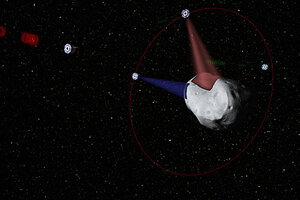How asteroid mining could turn billionaires into trillionaires
A cadre of Silicon Valley tycoons have announced plans to extract water and precious metals from near-Earth asteroids. Could that actually work?

This computer-generated image provided by Planetary Resources, a group of high-tech tycoons that wants to mine nearby asteroids, shows a conceptual rendering of satellites prospecting a water-rich, near-Earth asteroid.
Planetary Resources/AP
Cape Canaveral, Fla.
Google Inc executives Larry Page and Eric Schmidt and filmmaker James Cameron are among those bankrolling a venture to survey and eventually extract precious metals and rare minerals from asteroids that orbit near Earth, the company said on Tuesday.
Planetary Resources, based in Bellevue, Washington, initially will focus on developing and selling extremely low-cost robotic spacecraft for surveying missions.
A demonstration mission in orbit around Earth is expected to be launched within two years, said company co-founders Peter Diamandis and Eric Anderson.
Planetary Resources' aim is to open deep-space exploration to private industry, much like the $10 million Ansari X Prize competition, which Diamandis created.
The prize, which galvanized the emerging commercial human spaceflight industry, was awarded in 2004 to Scaled Composites' SpaceShipOne for the first flights beyond Earth's atmosphere by a privately developed, manned spaceship. Commercial suborbital spaceflights are expected to begin next year.
Planetary Resources' first customers are likely to be science agencies, such as NASA, as well as private research institutes.
Within five to 10 years, however, the company expects to progress from selling observation platforms in orbit around Earth to prospecting services. It plans to tap some of the thousands of asteroids that pass relatively close to Earth and extract their raw materials.
Not all missions would return precious metals and minerals to Earth. In addition to mining for platinum and other precious metals, the company plans to tap asteroids' water to supply orbiting fuel depots, which could be used by NASA and others for robotic and human space missions.
"We have a long view. We're not expecting this company to be an overnight financial home run. This is going to take time," Anderson said in an interview with Reuters.
The real payoff, which is decades away, will come from mining asteroids for platinum group metals and rare minerals.
"If you look back historically at what has caused humanity to make its largest investments in exploration and in transportation, it has been going after resources, whether it's the Europeans going after the spice routes or the American settlers looking toward the west for gold, oil, timber or land," Diamandis said.
"Those precious resources caused people to make huge investments in ships and railroads and pipelines. Looking to space, everything we hold of value on Earth - metals, minerals, energy, real estate, water - is in near-infinite quantities in space. The opportunity exists to create a company whose mission is to be able to go and basically identify and access some of those resources and ultimately figure out how to make them available where they are needed," he said.
Diamandis and Anderson declined to discuss how much money has been raised for their venture so far. In addition to Google billionaires Page and Schmidt and filmmaker Cameron, Planetary Resources investors include former Microsoft chief software architect Charles Simonyi, a two-time visitor to the International Space Station, Google founding director K. Ram Shriram and Ross Perot Jr.
Planetary Resources also declined to discuss specifics about how and when asteroid mining would begin. A 30-meter long (98-foot) asteroid can hold as much as $25 billion to $50 billion worth of platinum at today's prices, Diamandis said.
The company's first step is to develop technologies to cut the cost of deep-space robotic probes to one-tenth to one-hundredth the cost of current space missions, which run hundreds of millions of dollars, Diamandis said.
Among the targeted technologies is optical laser communications, which would eliminate the need for large radio antennas aboard spacecraft.
"We're taking new approaches at design," Diamandis said. "Part of the philosophy we're taking is building very low cost, very small spacecraft. You put up six or 10 or dozens and you get reliability."
Planetary Resources, which currently employs about 20 people, is overseen by former NASA Mars mission manager Chris Lewicki. It was founded about three years ago, but has been operating quietly behind the scenes until now.

